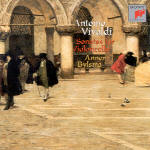Although Vivaldi’s six sonatas for cello and continuo share the same slow-fast-slow-fast four-movement form, don’t presume that they’re fashioned from the same cookie cutter. Anner Bylsma reveals their distinct melodic profiles with his ever-dancing bow arm, vocally induced phrasing, and a sense of rhythm that is centered yet pliable. We normally expect a continuo realization to provide the steady pulse from which a soloist plays off or around. Instead, the combined archlute and organ evaporate into chordal mist, leaving Bylsma to pick up the rhythmic tab, so to speak. And the continuo cello part sometimes works its way into the soloist’s orb like a servant intent on upstaging the lord of the manor. The harpsichord takes over from the organ in the third, fourth, and fifth sonatas, adding needed textural variety and bite to the mix. My quibbles, though, shouldn’t detract from Bylsma’s intense, involved, and often moving artistry. And don’t forget to read the scholarly, entertaining booklet notes by H.C. Robbins Landon.
































